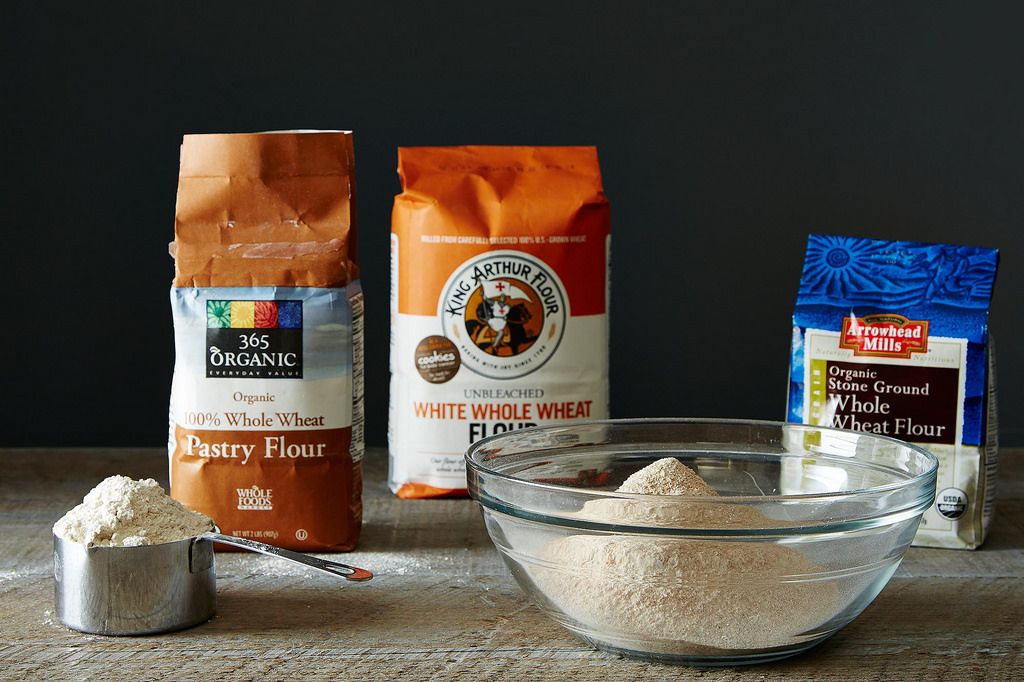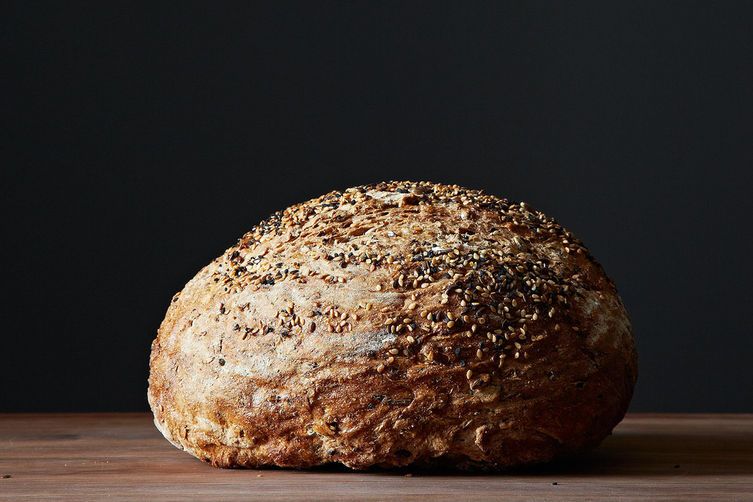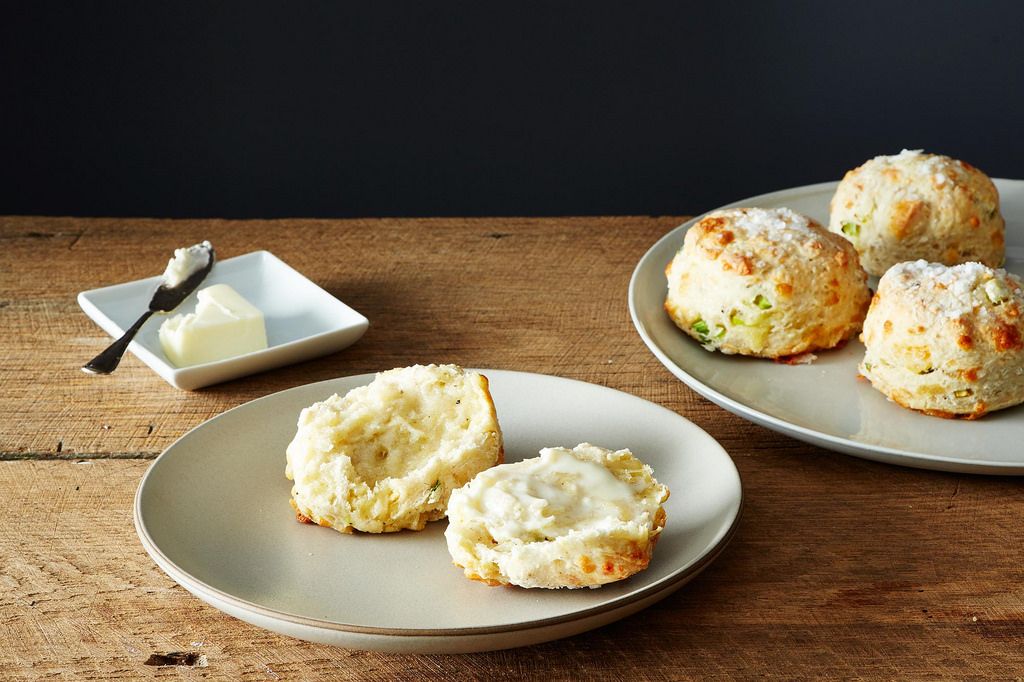Inspired by conversations on the Food52 Hotline, we're sharing tips and tricks that make navigating all of our kitchens easier and more fun.
Today: Learn to navigate all your whole-wheat options -- and start adding them to your favorite baked goods.

It's easy to turn blindly to all-purpose flour when baking. It's straightforward: white, pure, fine, and -- as its name suggests -- it can be used for all purposes. When it comes to whole-wheat flour, all you really know is that it's healthy and you should be using more of it -- but all the varieties can be a bit confusing.
More: Looking for recipes that use wheat-free flours? Try Alice Medrich's pancakes.
But today is your lucky day! We've gathered everything we know about whole-wheat flour, white whole wheat flour, and whole wheat pastry flour -- as well as advice from our trusted baking experts -- in one place. So, let's get down to the nitty gritty of -- well -- grittier flours. You'll soon see how they can add a distinct depth of flavor to your baked goods.

Whole-Wheat Flour
What it is:
-
Real whole-wheat flour is made by grinding whole red wheat berries -- the bran, germ, and endosperm -- quite literally, the whole grain. However, it's important to note that whole-grain flour differs from whole-wheat flour in that it undergoes no further processing once it's ground; nothing is lost in the process. Whole-wheat flour may undergo filtering that strips it of some nutrients.
- It's light brown in color (unless it's bleached -- which we don't recommend) with a sweet, nutty flavor. Because it includes all parts of the wheat berry, whole-wheat flour will give your baked goods a richer flavor.
- According to Erin McDowell, our Assistant Test Kitchen Manager, the presence of the germ and bran gives whole-wheat flour higher protein levels (up to 15%) than most bread flours. As a result, whole-wheat flour can make baked goods very dense, so it's most commonly combined with other lighter flours, like all-purpose.
- Pastry chef and Hotline MVP Shuna Lydon says that authentic whole-wheat flour can go rancid if your house or pantry runs warm because of the natural oils in the bran, so it's important to store it airtight glass jars and keep them away from all sources of light and heat.

How to Use It:
-
Try it in more robust recipes, like Irish soda bread, oatcakes, crackers, lavash, chocolate chip cookies, pancakes, waffles, and yeasted breads.
-
Erin prefers to never use all whole-wheat flour in a recipe -- she almost always combines it 50/50 with a lighter flour, most commonly all-purpose.
-
Don't use it in more delicate pastry recipes, like yeast-raised pastries (croissants and doughnuts, for example), pie or tart crusts, puff pastry, or items high in fat, unless in combination with a lighter flour -- like whole-wheat pastry flour.
-
Test your ratios. Shuna suggests to start by substituting 10 to 15% of the total flour your recipe calls for with whole-wheat flour. As you get more comfortable with the dough, you can play with the ratio based on your experience and results.
She also notes that, since whole-wheat flour tends to be higher in protein, it's easier to overmix and thus toughen what you're baking; this flour begs for hydration and becomes dry quickly. So, the more whole-wheat flour you use, the more liquid you need -- try another splash of milk or another egg. Feel it out until you have your desired consistency.
White Whole-Wheat Flour
What It Is:
- Contrary to popular belief, white whole-wheat flour is not just bleached whole-wheat flour. In fact, it's made from a completely different wheat berry: the hard white wheat berry.
Compared to the red wheat berry, the white berry's bran produces a lighter color and sweeter taste. As opposed to whole-wheat flour, which tastes nutty, white whole-wheat flour is more mild-tasting. It's a good choice for people who want the nutritional benefits of whole-wheat, but don't like the earthy whole-wheat taste.
-
White whole wheat is also slightly lower in protein than regular whole wheat, which makes for a lighter flour with a protein content between 12 and 13%. It is therefore closer in structure to all-purpose flour and can more successfully replace it 1:1 in standard recipes.

How to Use It:
-
Erin stresses that, when substituting white whole-wheat flour in recipes, it's important to remember that it is still whole-wheat, which can pose baking challenges -- like heaviness in the final product. Although all-purpose flour can usually be substituted 1:1 with white whole wheat flour, some recipes might come out too dense. In these cases, she suggests using 75% white whole-wheat flour and 25% all-purpose bread, cake, or pastry flour. However, in recipes already containing whole-wheat, white whole-wheat can replace the flour 1:1 almost without exception.
- This Yogurt Bread with Molasses uses white whole-wheat flour -- add whatever mix-ins you like.
-
The ratio also depends on the baked good you're making. For example, you can substitute white whole-wheat flour for all of the all-purpose flour in denser recipes like oatmeal cookies or gingerbread, but probably not for airier, flakier baked goods like biscuits. Plus, if you use it heavily in light-colored baked goods, you'll see a difference in color you might not necessarily want.
Whole-Wheat Pastry Flour
What It Is:
- A common misconception is that you can turn whole-wheat flour into pastry flour by blending it in a food processor. Indeed, whole-wheat pastry flour is a finer grind, but it's made from soft white wheat berries. Like the other whole-wheat flours, the berries are also milled with the nutritious bran, germ, and endosperm all intact.
- According to Erin, the soft white wheat berry is naturally lower in protein (about 9 to 10%), which produces a softer flour. Out of all these flours, whole-wheat pastry flour is the closest to traditional all-purpose flour, so in many cases, whole-wheat pastry flour is the best 1:1 substitute for all-purpose flour in baking recipes. That being said, this flour is still denser than all-purpose -- so be sure to test your recipes before assuming that substituting will work.

How to Use It:
-
K'lee says that, since whole-wheat pastry flour has a very low protein content, it's best used in recipes that don't rely on a lot of gluten and when a lighter, crumblier texture is desired.
-
Use it for recipes that rely on baking soda or baking powder -- not yeast -- like banana bread, muffins, scones, pie and tart crusts, biscuits, cookies, and quick breads. For more delicate baked goods, your best bet is to use 50% all-purpose and 50% whole-wheat pastry flour.
Now that your know your white whole-wheat from your whole grain, it's time to bake -- start experimenting, and be sure to let us know about your favorite places to use whole-wheat flours.
What are your favorite ways to use whole-wheat flours? Tell us in the comments!






See what other Food52 readers are saying.